
20 RIGHT & WRONG about sunscreens!
You may have wondered, "do I do it right", "what sunscreen should I choose" or "why did I got sunburned since I put on sunscreen"! We feel you! We' ve been at your shoes, and because we have been sunburned, we' ve learned (and we are going to share them with you) the key points that you should know about sunscreens! yellow blog is here to give you the RIGHT:answers in 20 common sunscreens, sunbathing, and child protection- mistakes!Sunscreen Selection & Conservation - 6 rights & wrong
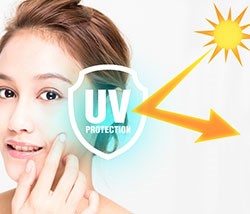
WRONG:You choose sunscreen according to the price or based on what a friend of yours bought.
RIGHT:Sometimes, the price factor or the opinions of those around us can be very bad advisors. Choose the RIGHT:sunscreen according to color, skin type, age, and frequency of sun exposure.
WRONG:You buy the most expensive sunscreen (thinking it's the best) without considering other factors than just the brand.
RIGHT:Sunscreens do not discriminate, nor do they have countermeasures (expensive vs cheap)! Whether a sunscreen is good has nothing to do with its price, but its ingredients, composition, skin, and needs.
WRONG:You get a sunscreen with SPF 60+ index, and you think that you are carefree!
RIGHT:Research shows that products with a very high protection index do not work as they claim on their label. Sunscreens are based on the SPF-Sun Protection Factor. This indicator mainly concerns UVB radiation, which is responsible for the slight redness after a few minutes of unprotected sun exposure. Equally important, though, is protecting your skin from UVA rays. UVB rays cause sunburn, and UVA causes more longer-term severe damage. Both types of radiation contribute to skin cancer, so it's essential to choose a sunscreen that can block both. For example, the UVB 20 sun protection index means that, without sun protection, you can stay in the sun for 30 minutes until your skin starts to blush, with the SPF 20 sunscreen, you can stay in the sun for 20 times longer. Therefore, ideally, you should choose a sunscreen with an SPF of at least 30+ and a maximum of 50 (sunscreens with an SPF of 50 blocks 98% of the sun radiation).
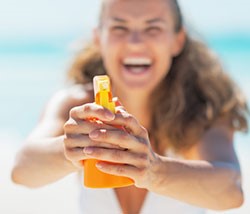 WRONG:You discovered your last year's sunscreen at the bottom of your beach bag. It's not over, and you're going to use it this summer since you're happy with it. When it's over, you'll get another one.
WRONG:You discovered your last year's sunscreen at the bottom of your beach bag. It's not over, and you're going to use it this summer since you're happy with it. When it's over, you'll get another one.RIGHT:At the beginning of each summer, you have to buy new sunscreens because they have an expiration date and a lifespan of about a year. As time passes by, the composition changes, and this can result in lower protection, as well as in possible irritation. Also, sunscreens are affected by heat and sun, so if you see a change or separation in their texture, you should not use them. Finally, if you notice a skin reaction, e.g., redness, stop using it immediately.
WRONG:You leave the sunscreen exposed to the sun and the heat - after all, isn't it for the sun?
RIGHT:Each sunscreen preserves its composition and, therefore, its effectiveness when stored at specific temperatures. Overcoming these is altering its chemical composition. When you're on the beach, prefer to leave it in the bag, ideally in the shade. Caution! If you leave the sunscreen in the sun, there is a chance that you will get a sunburn when it comes in contact with your skin.
WRONG:You put sunscreen on your face and body, consider yourself "ok".
RIGHT:You need to protect every exposed part of your body. There are many spots on our body that we forget or don't pay much attention. That is of course, until we get burned! To be more specific the neck, the ears, the nose, the upper part of the foot, the upper part of the hand (outside the palm), the toes as well as the back of the calf and thigh, are areas we usually forget to put sunscreen and finally get burned!
Suncream Application - 5 rights & wrong
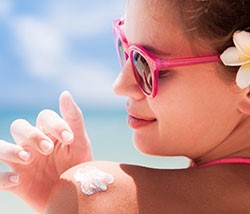
WRONG:You apply sunscreen only once (either for the economy or because you think that because it's waterproof, it lasts longer), and you think you're covered for the whole day!
RIGHT: All sunscreens last for about 2 hours, except if you swim or sweat, so you need to apply it again. According to dermatologists and multiple scientific studies, you should apply each time, a quantity of sunscreen corresponding to half small wine glass for every hour you are in the sun. Unfortunately, most of us use only 1/4 or half of the above-recommended dosage, mainly for the economy.
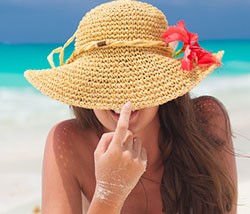 WRONG:You use the body sunscreen on your face. Why not? At the end of the line they are both suncreams, aren't they?
WRONG:You use the body sunscreen on your face. Why not? At the end of the line they are both suncreams, aren't they?
RIGHT:The skin of the face has nothing to do with the skin all over the body, it is much thinner and more sensitive, and that is why it needs more specialized protection. Be sure that the face sunscreen products are especialy made for this area exclusively!
WRONG:You use a low protection index to tan more easily.
RIGHT:Don't worry about your tan, because you also tan with a large protection index. In fact, in this way, you achieve your tan gradually and not abruptly, and so it is maintained for much longer. Scientific studies have shown that direct exposure to the sun (and even using sunscreen with a low protection index) increases the chance of developing skin cancer more than gradual exposure. So don't sit in the sun for hours without sunscreen or low protection index because you don't have a win-win situation!
WRONG:You arrive at the beach, you arrange your things, take a dive to cool off, swim a little, go out, and at the end, you put on sunscreen.
RIGHT:The sunscreen works and protects you from the harmful sun radiations 20'-30 'after its application. That's why you have to put on sunscreen BEFORE you go to the beach.
WRONG:You apply the sunscreen gently and fast (as if you are chased)!
RIGHT:Proper application of sunscreen requires a smooth and equal application. The instructions for all cream preparations provide a uniform passage of the palm, 10-12 times from each area. Only then will you have effective protection.
Kids & Sunscreen - 4 rights & wrong
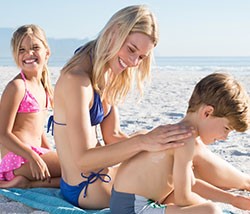
WRONG:You use your kids' sunscreen just because it has a high protection index.
RIGHT:There is a reason why children's sunscreens are on the market. Children have much more sensitive skin and require special care. Childrens' sunscreens are divided into those containing natural ones (minerals) and are intended for younger children and those containing chemical filters (organic). Inorganics reflect ultraviolet radiation, leave a white film on the skin, and are ideal for infants, toddlers, but also for children with atopic dermatitis and chemical intolerance. Sunscreens with chemical filters absorb sunlight; do not allow it to damage the lower layers of the skin and are ideal for children older than 1 year (who do not show intolerance to organic filters).
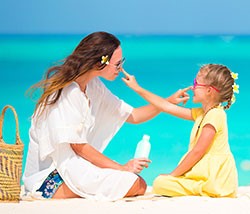 WRONG: You took your baby, who is not yet half a year old, and you went to the sea in the afternoon! What's the matter, it's afternoon! You also put sunscreen on him!
WRONG: You took your baby, who is not yet half a year old, and you went to the sea in the afternoon! What's the matter, it's afternoon! You also put sunscreen on him!RIGHT: Pediatricians are absolute to this: the sunscreen is allowed to babies over 6 months. The reason is that their skin is extremely sensitive to exposure to both the sun's ultraviolet radiation and the substances contained in sunscreens! So have a little patience, and you will have plenty of time for squabbles with your baby!
WRONG: You did apply sunscreen on your kid. It plays on the beach and goes in and out of the water! You enjoy its play because you know you used waterproof sunscreen for kids!
RIGHT: We're sorry to tell you, but waterproof doesn't mean "you put it on and got rid of it"! Unfortunately, once the baby /kid comes in and out of the water, you must reapply the sunscreen. A general rule to keep in mind is that sunscreen disappears from the skin after a 15-minute bath.
WRONG: You send the child to school or to the camp without applying sunscreen, because where have you heard to put sunscreen at school!
RIGHT: A number that most of us are unaware of is that children receive 80% of the total solar radiation they are going to get in their entire lives, the first 20 years of their life. So, just as we have to apply sunscreen every day, regardless of the season!
Suntunning - 4 rights & wrong

WRONG: You sit in the sun for the hottest hour to tan faster or because that's how the companionship dοes!
RIGHT: Wrong, wrong, wrong… big mistake! And I don't know if we mentioned it, but it's a huge mistake! We NEVER sit directly in the sun between 12 p.m. and 4 p.m.. Not negotiable!
WRONG: You are in the car, on the bike or you are just walking in the alleys of the island, the city and you are not wearing sunscreen, because you think that sunscreen is only for the beach!
RIGHT: The sunscreen is not for hanging out with the beach bag! Use it even when you think you don't need it (eg, in the car, under a sea umbrella, in the clouds). Remember that reflections on buildings, sea, sand, etc. send solar radiation too.
WRONG: Because you use sunscreen you don't wear a hat!
RIGHT: To avoid photoaging around the eyes, photokeratitis and conjunctivitis, always wear a hat with a large brim and dark sunglasses. Don't be fooled by the cloudy days, because the solar radiation does not cease to exist. Also, know that the sea umbrella protects from the sun at a rate of 15%, while seawater only at 5%! Finally, clothes that protect from sunlight are only those that have a dense texture, those through which you can not see if you lift them in the sun. But if they get wet, they lose about 50% of their sun protection.
WRONG: You follow the idea, "I use sunscreen until I tan and then I don't have to put it on again".
RIGHT: The fact that you have tanned does not make your skin invulnerable to the sun's rays! Use a sunscreen with a high protection index at the beginning, and as much as you tan, you can, if you want, reduce the protection index from 50 to 25.
Sunburned!!! | right & wrong
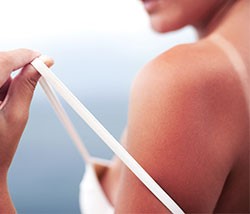
WRONG: Eventually, you stepped on it and became like a mullet and wondered what to spread on your burnt and aching body: Yogurt, toothpaste, or maybe butter?
RIGHT: The first thing you need to do is carefully remove the clothes and moisturize the affected area with running cool water for at least 3 minutes. In this way, you reduce the depth of the burn and protect the skin's deeper layers from additional damage. Immediately after, you apply some after-sun cream (ideally, always have it in the fridge, to make it even cooler) and not some home-made medicine. Caution: if bubbles or wounds have formed, you don't touch them! Contact a doctor immediately to evaluate the severity and extent of the burn and provide all the necessary treatment instructions.

Now, you know what is right and what is wrong! Follow the guide above, and you will definitely have a beautiful summer, properly protected from the sun! Play, laugh, and have fun on the beach, but don't forget the 20 "right" ones! Don't get carried away, and don't be embarrassed to ask for help on which product is best for your needs. And don't forget, that for whatever you need this summer, from holiday suggestions to all the essentials for the beach, you will find them to the yellow Partners, and by using Piraeus Bank cards participating in the Program, you earn or redeem yellows!
Happy Summer!

